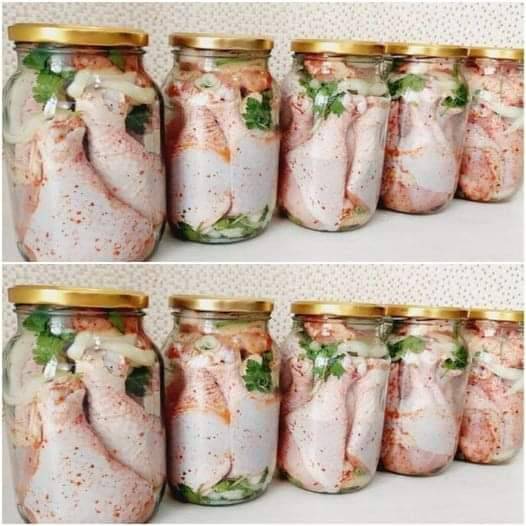ADVERTISEMENT
How to Smoke Chicken:
- Prepare the Chicken: Clean and prepare the chicken, either whole or cut into parts. It’s common to brine or season the chicken with spices and herbs before smoking to add flavor.
- Set Up the Smoker: Heat your smoker to a low temperature (around 200-225°F/93-107°C). Use wood chips like hickory, apple, or cherry for a great flavor.
- Smoke the Chicken: Place the chicken in the smoker, making sure it’s not directly above the heat source. Smoke the chicken for several hours, turning occasionally, until the internal temperature reaches 165°F (74°C). The outer skin should be dry and slightly crisp, and the meat should be tender and juicy.
- Store the Smoked Chicken: Once the chicken is smoked, you can store it in a cool, dry place. If you plan to store it for a long period, consider vacuum sealing it and storing it in a cool, dry location. Smoked chicken can last for a few days at room temperature but should be eaten within a week or so.
3. Drying (Dehydrating) Chicken:
Drying or dehydrating chicken is another excellent way to preserve it without refrigeration. By removing the moisture from the meat, you significantly reduce the potential for bacteria to grow.
How to Dry Chicken:
- Prepare the Chicken: Cut the chicken into thin strips or small pieces. If you’re drying chicken breast, make sure to trim off any excess fat, as fat can go rancid quickly.
- Seasoning: You can marinate the chicken in your favorite spices or a brine solution before drying. This adds flavor and helps with preservation.
- Dehydrate: Use a food dehydrator or your oven to dry the chicken. For a dehydrator, set it to 160°F (71°C) and dry the chicken for 6-10 hours, depending on the thickness of the pieces. If using an oven, place the chicken on a rack over a baking sheet and leave the door slightly ajar to allow moisture to escape. Drying chicken in the oven at 170°F (77°C) can take up to 6 hours.
- Storage: Once completely dried, store the chicken in airtight containers, vacuum-sealed bags, or mylar bags with oxygen absorbers. Dried chicken can be stored for 6-12 months in a cool, dry, and dark place.
4. Salt-Curing Chicken:
Salt-curing is another age-old method of preserving meat without refrigeration. Salt draws moisture out of the chicken, preventing bacterial growth. This method works best for whole chickens or large cuts of chicken.
How to Salt-Cure Chicken:
- Prepare the Chicken: Clean and trim the chicken, removing any feathers or skin you don’t want to keep.
- Salt the Chicken: Liberally rub salt onto the chicken. For best results, use kosher salt or sea salt. Make sure to cover every surface of the meat, including inside the cavity if you’re doing a whole chicken. You can also add sugar to the salt mixture for a sweet-salty flavor.
- Cure the Chicken: Place the salted chicken in a cool, dry place and let it cure for several days. During this time, the salt will draw out moisture and preserve the chicken.
- Storage: After curing, you can store the salted chicken in a cool, dark area. Be sure to check the chicken regularly for signs of spoilage. Salt-cured chicken can last for several weeks or even months, but it’s important to always check the condition before consuming.
5. Pickling Chicken:
Pickling is an effective method for preserving chicken, particularly for creating a tangy, flavorful dish. By immersing the chicken in an acidic brine (often vinegar-based), you can keep it safe for several days without refrigeration.
How to Pickle Chicken:
- Prepare the Chicken: Cut the chicken into smaller pieces and boil it briefly to ensure it’s cooked through.
- Make the Pickling Brine: Combine vinegar, water, salt, and spices like garlic, bay leaves, mustard seeds, and peppercorns. Bring the mixture to a boil and then let it cool.
- Pickle the Chicken: Place the boiled chicken pieces in clean, sterilized jars and pour the brine over the chicken, making sure it is fully submerged.
- Storage: Store the jars in a cool, dark place. Pickled chicken can be eaten after several days and will last for up to a few weeks if stored properly.
Important Safety Tips for Preserving Chicken Without Refrigeration
- Use Proper Sanitation: Cleanliness is key. Always sterilize your canning jars, utensils, and work surfaces to prevent contamination.
- Monitor Temperature: When using methods like smoking or dehydrating, ensure that the chicken reaches a safe internal temperature of 165°F (74°C) to kill any harmful bacteria.
- Check for Spoilage: No matter which preservation method you use, always check the chicken for any signs of spoilage, such as an off smell, discoloration, or mold growth. If anything seems off, discard the chicken immediately.
- Store Properly: For the longest shelf life, store preserved chicken in airtight containers in cool, dry, and dark environments. Avoid storing in places that are prone to humidity or extreme temperatures.
Conclusion: Preserving Chicken Without Refrigeration
While refrigeration may be the most common method for preserving chicken today, it’s certainly not the only option. Whether you’re looking to prepare for a camping trip, a power outage, or just want to experiment with traditional food preservation techniques, the methods outlined above can help you store chicken safely and without refrigeration. From canning to drying, pickling, and salting, these tried-and-true methods have stood the test of time for a reason.
By using these techniques, you can enjoy the satisfaction of preserving your own food and ensure that your chicken stays safe, flavorful, and ready to eat, even when refrigeration isn’t an option.
ADVERTISEMENT
